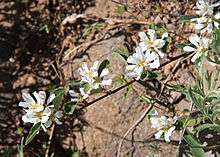Amelanchier utahensis
| Utah serviceberry | |
|---|---|
 | |
| Scientific classification | |
| Kingdom: | Plantae |
| (unranked): | Angiosperms |
| (unranked): | Eudicots |
| (unranked): | Rosids |
| Order: | Rosales |
| Genus: | Amelanchier |
| Species: | A. utahensis |
| Binomial name | |
| Amelanchier utahensis Koehne | |
 | |
| Natural range of Amelanchier utahensis | |
Amelanchier utahensis, the Utah serviceberry, is a shrub or small tree native to western North America. This serviceberry grows in varied habitats, from scrubby open slopes to woodlands and forests.

Description
Amelanchier utahensis is a spreading plant, reaching a maximum of five meters (15 feet) in height. It is deciduous, bearing rounded or spade-shaped often toothed green leaves and losing them at the end of the season. In April and May the shrub blooms in short inflorescences of white flowers, each with five widely spaced narrow petals. The fruits are pomes. The Utah serviceberry is browsed by desert bighorns, elk, and mule deer, as well as many birds and domesticated livestock.
Range
For the Utah Serviceberry, the core mountainous range is delimited by the Colorado–New Mexico–Wyoming Rocky Mountains[1] in the east, the Front ranges of Utah at the west, and the south in central Arizona-western New Mexico by the Mogollon Rim and White Mountains (Arizona) region[2] of east Arizona and New Mexico.
The rest of the range is centered on mountain ranges of the Great Basin, and extending west to the Sierra Nevada and chaparral and woodlands in California and as far south as extreme northern Baja California, and then in the north to southwestern Montana with Idaho.[3]
References
| Wikimedia Commons has media related to Amelanchier utahensis. |
- Little. Atlas of United States Trees, Volume 3, Minor Western Hardwoods, Little, Elbert L, 1976, US Government Printing Office. Library of Congress No. 79-653298. Map 17, Amelanchier utahensis.
External links
- Jepson Manual Treatment = Amelanchier utahensis
- USDA Plants Profile: Amelanchier utahensis
- Ecology
- Amelanchier utahensis in the CalPhotos Photo Database, University of California, Berkeley
- Lady Bird Johnson database, w/ gallery